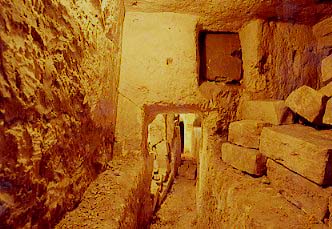
The Hypogeum Complex under the Wignacourt Collegiate Museum

|
Location: | |
|
The Wignacourt Collegiate Museum may be found to the right of St.Paul's Church in Rabat, Malta | |
|
Introduction The Mdina promontory, used by the local Bronze Age culture, was transformed into the city of MLT by the Phoenicains and expanded by the Romans to the city of Melite. This Roman town extended from present day Mdina to the area occupied today by St. Paul's Church in Rabat. In fact the latter church and the straight street (St. Rita) in front of it stands on a man made depression considered to be the Roman ditch of this city. On various occassions remains of this Roman city have been found, the most noteworthy of which being the remains of the Roman domus often erronously referred to as the Roman Villa |
|
|
|
As burials were only allowed outside the city walls, an extensive burail site has resulted in what today is the Southern part of Rabat. Here two main sites are known. A space formerly used as a chapel greets the visitor to St. Paul's Catacombs,which consists of a central communal cemetery to which a number of small hypoegea have been attached. |
|
A second complex is found further down the road and is knwon as St. Agatha's catacombs. Once again a chapel this time embellished with a series of medieval frescoes is found just below the modern entrance, and a passage to the right leads into a series of family hypogea that can be visited in this place.
|
|
|
The modern entrance of another complex was rediscovered in 2002 making public access to the hypogeum complex under the Wignacourt Collegiate Museum possible
| |
Contact author by E-Mail
(c) Images and Text Anton Bugeja July 2003